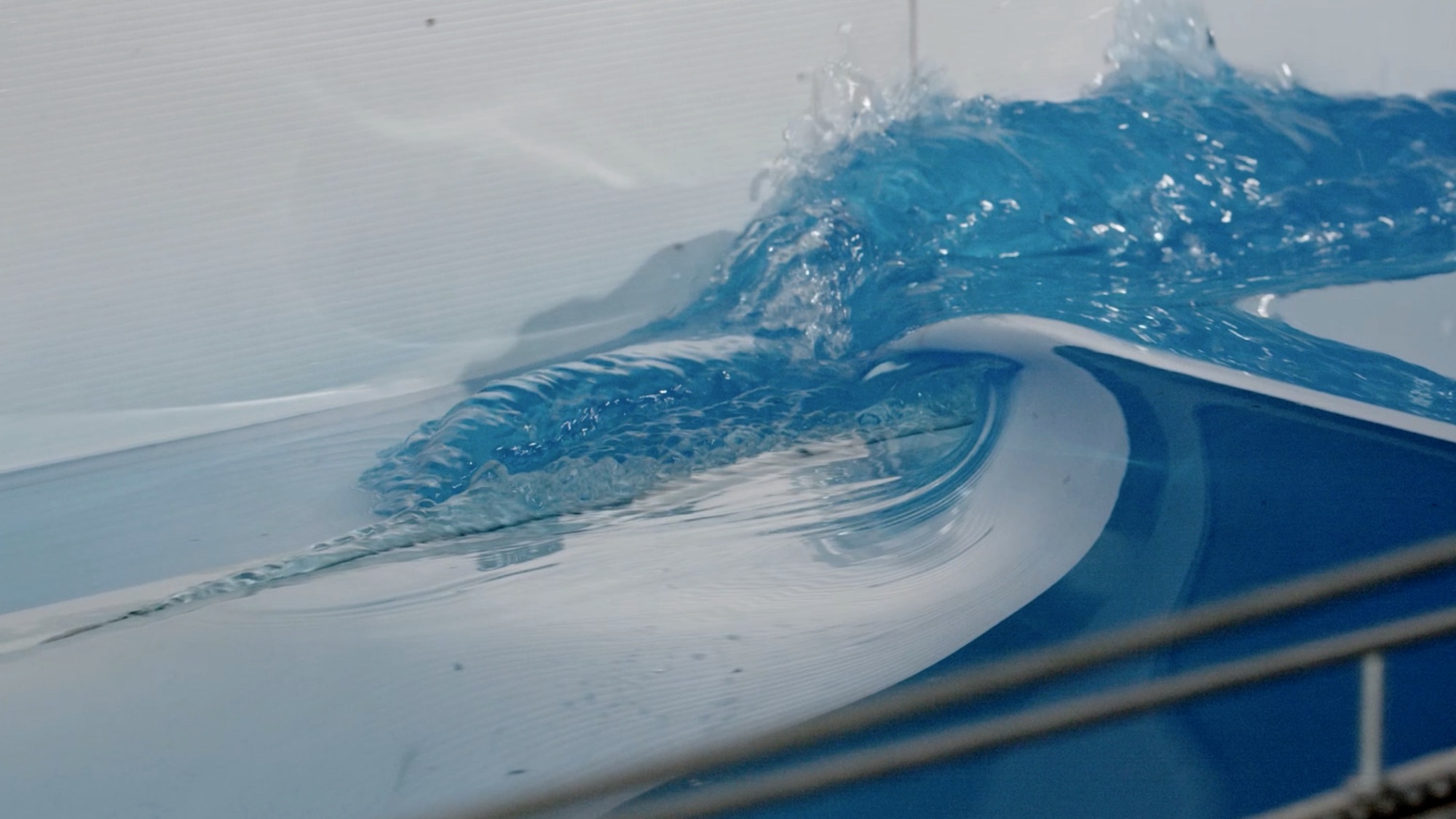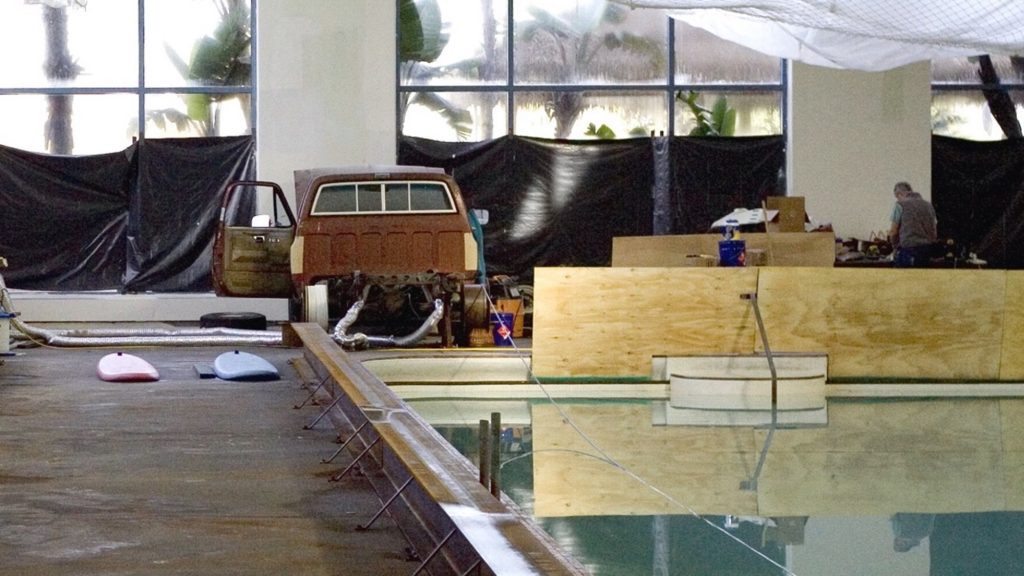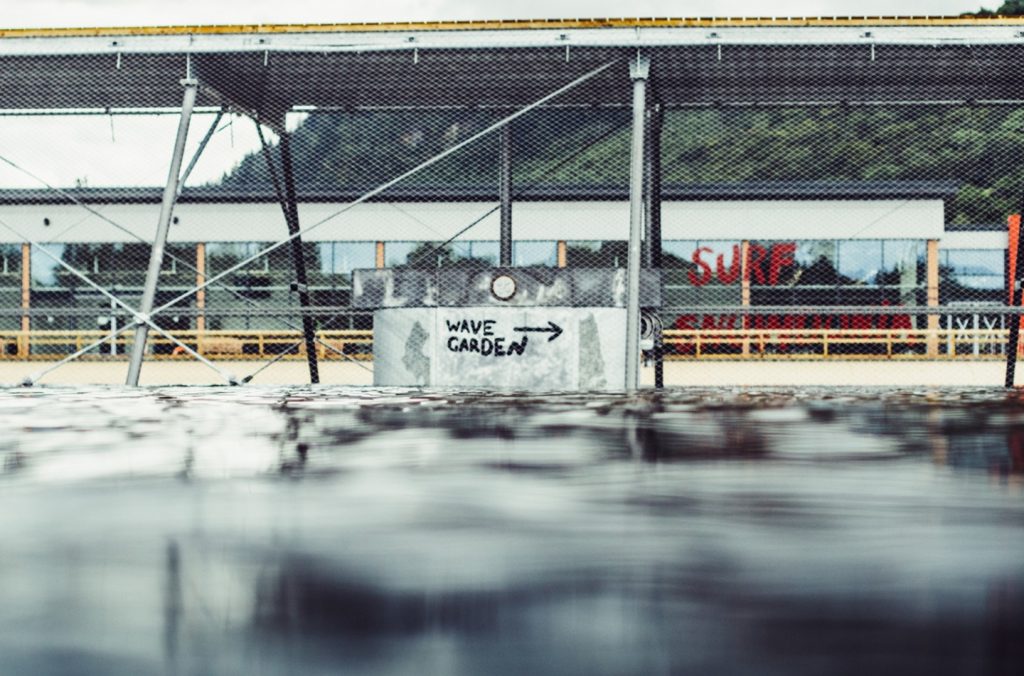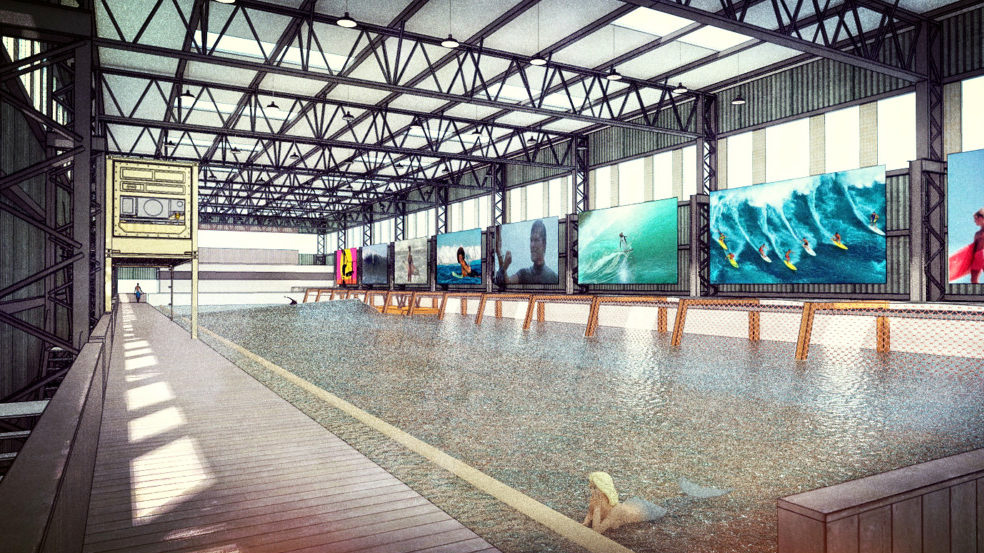Foiled! A closer look at the techs that kicked off wavepools 2.0

How do wave pools with foils work? Plows, foils, sleds – there are many names for this type of wave generation device which works by pulling a piece of metal, resembling a ship’s bow, along a track to create a wave. Some devices use a locomotive-type engine to push the plow, while others use cables to pull it along. Fun Fact: Original tests of this concept by Wavegarden used a farming tractor to pull the foil device. Find out more in the below guide.

WavePoolMag HQ received a communication recently featuring a beautiful, slabby, Liliputian barrel generated by a new design. Demonstrated in a test tank, the Skeleton Bay for mice rekindled our stoke for plow systems. We thought it was time for a review of these systems.
Ten years ago when Wavegarden brought touring pros to the Basque Country to sample their knee-high drainers, it was a game-changer. Suddenly wave pools were possible. Soon, Adventure Parc Snowdonia opened up, as well as NLand, followed by Kelly’s unveiling of the Gold Standard plow design.
As surf parks gained in popularity, “throughput” became a deciding factor in which technology they chose. Most commercial surf pools generate between 150-400 waves per hour for paying clientele. Plow systems are limited in the number of waves they can generate each hour with Kelly’s pumping out between 12 and 18 depending on the setting.
So what are the wave technologies using the foil design and how do they work? Here is a list of foil technologies taken from our Wave Technology Guide

The first of the wave pool 2.0 generation to break ground nearly a decade ago is alive and well at Adventure Parc Snowdonia. This is the beast that launched the whole revolution while Kelly, Greg Webber, Lochtefeld and others were still in the lab. Developed deep in the Basque Country of Spain, the world woke to the Lagoon in 2010 via low-res YouTube videos. With the prototype an hour drive from Hossegor, Wavegarden’s launch benefited greatly from traveling CT pros who made the small waves look doable. This first prototype, a plastic-lined pond about the size of your corner 7-Eleven, gave way to a revamped design in a larger pond. This larger model showed us the full potential and included a pier running down the center of the wave pool. The first full-scale Lagoon went up at Surf Snowdonia in 2015. Another one opened in Austin Texas shortly afterward.
The system works like Kelly’s wave system and the China wave pool. A submerged hydrodynamic wave foil (hull) powered by a gearless drive system runs down a central track that splits the rectangular lagoon. The hull moves at a speed between 4.5m and 7.5m (14.7ft-24.6ft) per second and pushes out a large wake that breaks along either side of a central pier creating a right and a left simultaneously. Speed of the foil determines the size of the wave generated. Once the swell is pushed out it interacts with the shallows of the lagoon bathymetry to form the wave we see today. A right and a left between 2-to- 6-feet high on the face can be generated roughly every 90 seconds with rides up to 30 seconds long. Despite commercial viability obstacles including a low waves-per-hour count and the pool requiring a long, straight piece of land, the lagoon started the wave pool revolution we see today and anchors the ever-popular Adventure Parc Snowdonia facility in Wales.
Kelly’s design is the most famous of the wave pools. The prototype transformed an abandoned waterski park in Lemoore California into the upscale Surf Ranch, the darling of the WSL and company team-building power perk for the Fortune 500 surf set. The system is a simple plow design, like Wavegarden’s Lagoon and Surf Poel in The Hague. A specially designed submerged foil is pulled down a straight track at high (or low) velocity, displacing water to create a wave that breaks along the wave pool’s specially designed bathymetry. Adjustments to the large, noisy machine temper the speed of the plow affecting the wave’s steepness and size. Unlike the Wavegarden Lagoon, Kelly’s wave plow only generates a rideable swell on one side of the track. But it is bi-directional, going in one direction to create lefts and the other direction to create rights. The pool is 700 meters long by 150 meters wide (2,200 feet by 500 feet) with the ride at Kelly’s, clocking in at 45 seconds – the longest of any of the world’s wave pools to date. A wave is generated about every two minutes and ranges in size from 3-to-6-feet. It takes 3-4 minutes for the water to calm between waves.
The Kelly Slater Wave Company has suffered setbacks in Florida, Coolum Australia and elsewhere as they struggle to make the system cost-effective for the work-a-day surfer while getting approval from local authorities. Plans to expand elsewhere in Australia and in Texas, as well as Japan, are hot with speculation as the world anticipates the first public dream wave. A development for a Kelly Slater Wave Co tank in the desert east of Los Angeles is moving forward rapidly.
Greg Webber’s fertile mind has been spitting out wave pool and artificial reef concepts for years. His latest is a system on a looped steel rail track fitted with wheeled carriages. “Like a carriage on an urban monorail system,” he says. Wave-making hulls are attached to the wheeled carriages which are driven by electric motors. All of it controlled by hydraulic actuators – those piston-looking things mounted on heavy equipment scoops and blades. The controlling of the carriages helps adjust the wave height, angle, etc.
Still with us? Good. Software controls the speed and the draft and the angle of each hull. Small changes in these three elements result in immediate changes to the wave size and shape. The takeaway? Instead of a fixed plow lumbering down a track pushing out a straight wave, Webber’s wave maker travels along an oval track and has room for several minute adjustments. The system works in conjunction with a current maker which uses a super-secret method of mitigating unwanted currents while also directing them to enhance the waves. The wave pool will produce a 25-second ride with waves in the 5-to-6-foot range with the capability to go up to 7-to-8-feet and producing 120-180 waves per hour. After nearly 20 years of hearing about Webber Wave Pools, Coral Springs Florida is on the map as the first place to develop Webber’s system.
A giant foil runs down a track to produce waves on the right and left sides of a central pier. The Chinese Government is backing this design to train athletes for the Olympics so it’s unknown as to how far this design will extend commercially to the rest of the world. The pool is a 700-meter long rectangle with a width of 150 meters. The central machine’s velocity and foil is adjusted to vary wave size and type. Wave frequency is low, even by plow standards with a right and a left generated once each six minutes. This is most likely due to water needing to settle between waves. Surf height is in the 2-to-4-foot range with soft-breaking waves.
Some reports state that the wave is hollow at the beginning and at the ending of the plow’s run. As the system’s builders aren’t looking for buyers just yet (meaning no promotional materials) this wave-making device is likely to remain a mystery for quite some time. Location is in China and will probably remain so.

The Dutch indoor wave pool project SurfPoel is fast under construction and hopes to open shortly. Although we couldn’t pin down a specific launch date, from the looks of the social media feed from parent company 24/7 waves, it looks like it won’t be long once COVID-19 restrictions are lifted in The Netherlands. When completed the converted warehouse will host a hull and foil type of wave generator created by Australian Steven Schmied. For 10 years Schmied developed a system that can be adjusted to produce a variety of waves. Initial design sketches show a foil-and-track set up to be used inside a long rectangular warehouse. The pool itself will be 72m long (230 feet) and 18m (60 feet) in width with a max depth of 2,5m (8 feet). The building housing the pool is a massive 2400 square meters (7,800 square feet) and will use shipping containers and a timber beach to construct surrounding amenities.
On a larger scale, the company plans to build out their design elsewhere around the world, but seeing as Surf Poel’s social media feeds have been dormant lately, let’s hope it’s simply a COVID-related delay and not the evaporation of another wave pool. The surf scene in nearby Scheveningen is lively with a core group of Dutch and visiting German surfers crowding the lineups year-round. Surf Poel will add much-needed reliable surf to the area and reside in The Hague.
Related Coverage
